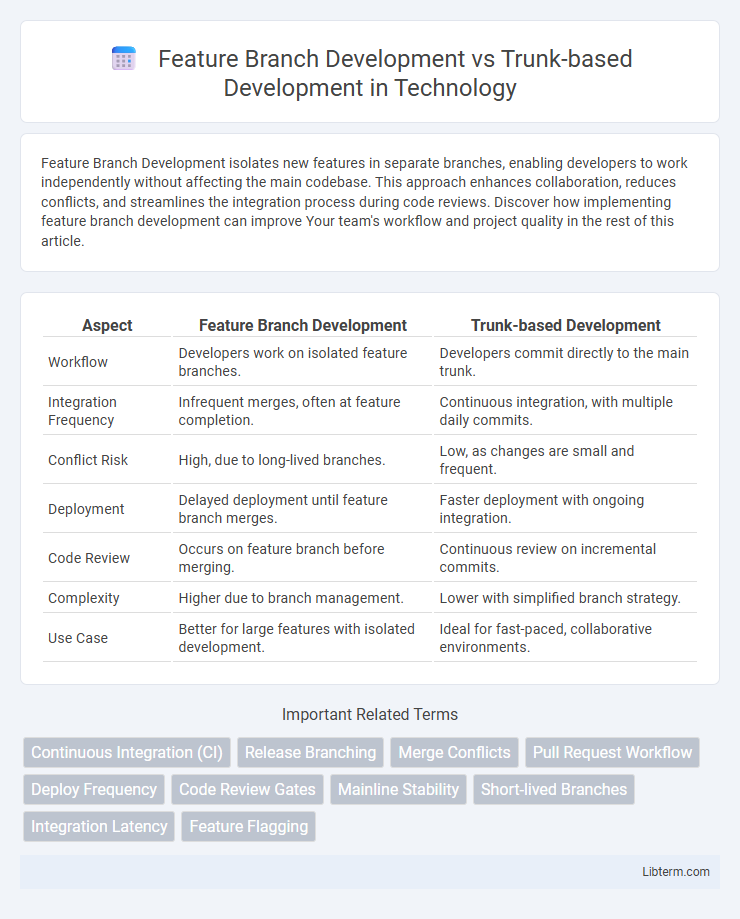Feature Branch Development isolates new features in separate branches, enabling developers to work independently without affecting the main codebase. This approach enhances collaboration, reduces conflicts, and streamlines the integration process during code reviews. Discover how implementing feature branch development can improve Your team's workflow and project quality in the rest of this article.
Table of Comparison
| Aspect | Feature Branch Development | Trunk-based Development |
|---|---|---|
| Workflow | Developers work on isolated feature branches. | Developers commit directly to the main trunk. |
| Integration Frequency | Infrequent merges, often at feature completion. | Continuous integration, with multiple daily commits. |
| Conflict Risk | High, due to long-lived branches. | Low, as changes are small and frequent. |
| Deployment | Delayed deployment until feature branch merges. | Faster deployment with ongoing integration. |
| Code Review | Occurs on feature branch before merging. | Continuous review on incremental commits. |
| Complexity | Higher due to branch management. | Lower with simplified branch strategy. |
| Use Case | Better for large features with isolated development. | Ideal for fast-paced, collaborative environments. |
Introduction to Feature Branch and Trunk-based Development
Feature Branch Development involves creating isolated branches in a version control system where developers work on new features independently, allowing parallel development and reducing conflicts. Trunk-based Development emphasizes continuous integration by having developers frequently commit small changes to a shared main branch, enhancing collaboration and minimizing merge complexities. Understanding these approaches helps software teams choose the best workflow for code stability and deployment efficiency.
Core Principles of Feature Branch Development
Feature Branch Development centers on isolating new features in separate branches, enabling developers to work independently without affecting the main codebase. This approach emphasizes frequent commits within the feature branch and thorough testing before integration, ensuring code stability and reducing conflicts. The core principle is to maintain a clean main branch, with feature branches merged only after successful completion and review.
Overview of Trunk-based Development Practices
Trunk-based development involves developers committing small, frequent changes directly to the main codebase, minimizing long-lived feature branches to reduce merge conflicts and integration challenges. This practice emphasizes continuous integration and rapid feedback, enabling teams to maintain a stable and deployable codebase at all times. By fostering collaboration and streamlining workflows, trunk-based development supports agile delivery and enhances overall software quality.
Workflow Differences: Feature Branch vs Trunk-based
Feature Branch Development isolates new features in separate branches, allowing parallel workstreams and detailed code reviews before integration, while Trunk-based Development promotes continuous integration by having multiple developers commit directly to the main trunk, minimizing merge conflicts and encouraging smaller, incremental updates. Feature branches often result in longer-lived branches and delayed integration, which can lead to integration challenges, whereas trunk-based workflows emphasize rapid feedback cycles and constant synchronization with the main codebase. The choice impacts release cadence, collaboration style, and risk management in software development teams.
Advantages of Feature Branch Development
Feature Branch Development enables isolated work on specific features, reducing the risk of integration conflicts by allowing developers to build and test independently before merging. It enhances code review effectiveness, as changes are encapsulated within dedicated branches, facilitating clear change history and accountability. This approach supports parallel development by multiple teams without disrupting the stable main codebase, improving overall project scalability and collaboration.
Benefits of Trunk-based Development
Trunk-based development accelerates software delivery by enabling continuous integration and minimizing merge conflicts, promoting higher code quality and collaboration among developers. It encourages smaller, incremental changes, reducing integration risk and simplifying debugging processes. This approach supports faster feature releases and improved team agility through streamlined version control workflows.
Common Challenges in Feature Branch Workflows
Feature branch development often encounters challenges such as merge conflicts, which arise from long-lived branches diverging significantly from the main codebase, causing integration difficulties. Delayed integration of feature branches can result in increased testing overhead and reduced code quality due to inconsistent code synchronization. Maintaining up-to-date branches requires frequent rebasing or merging, leading to developer overhead and potential context switching that impacts productivity.
Pitfalls of Trunk-based Development
Trunk-based development can lead to integration challenges and increased risk of conflicts when multiple developers commit frequently to the main branch without proper coordination. This approach may cause instability in the main codebase due to incomplete or untested features being merged prematurely. Furthermore, managing feature toggles and ensuring continuous integration pipelines are robust becomes critical to avoid deployment issues and maintain code quality.
Choosing the Right Approach for Your Team
Selecting the right development approach depends on your team's size, release frequency, and collaboration style. Feature Branch Development suits larger teams needing isolated work and controlled integration cycles, while Trunk-based Development supports smaller teams aiming for continuous integration and faster delivery. Evaluating your project's complexity, risk tolerance, and deployment strategy helps determine the most effective branching model for maintaining code quality and enabling rapid innovation.
Best Practices for Effective Source Control Management
Feature Branch Development promotes isolated code changes, enabling parallel workstreams with minimal conflicts, while ensuring frequent integration helps reduce merge issues. Trunk-based Development emphasizes continuous integration with short-lived branches or direct commits to the mainline, fostering faster feedback and greater collaboration. Effective source control management incorporates code reviews, automated testing, and consistent commit practices to maintain code quality and streamline deployment pipelines.
Feature Branch Development Infographic

 libterm.com
libterm.com